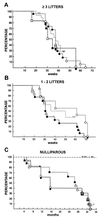Mouse mammary tumor virus/v-Ha-ras transgene-induced mammary tumors exhibit strain-specific allelic loss on mouse chromosome 4
- PMID: 9238034
- PMCID: PMC23068
- DOI: 10.1073/pnas.94.16.8664
Mouse mammary tumor virus/v-Ha-ras transgene-induced mammary tumors exhibit strain-specific allelic loss on mouse chromosome 4
Abstract
Hybrid mice carrying oncogenic transgenes afford powerful systems for investigating loss of heterozygosity (LOH) in tumors. Here, we apply this approach to a neoplasm of key importance in human medicine: mammary carcinoma. We performed a whole genome search for LOH using the mouse mammary tumor virus/v-Ha-ras mammary carcinoma model in female (FVB/N x Mus musculus castaneus)F1 mice. Mammary tumors developed as expected, as well as a few tumors of a second type (uterine leiomyosarcoma) not previously associated with this transgene. Genotyping of 94 anatomically independent tumors revealed high-frequency LOH ( approximately 38%) for markers on chromosome 4. A marked allelic bias was observed, with M. musculus castaneus alleles almost exclusively being lost. No evidence of genomic imprinting effects was noted. These data point to the presence of a tumor suppressor gene(s) on mouse chromosome 4 involved in mammary carcinogenesis induced by mutant H-ras expression, and for which a significant functional difference may exist between the M. musculus castaneus and FVB/N alleles. Provisional subchromosomal localization of this gene, designated Loh-3, can be made to a distal segment having syntenic correspondence to human chromosome 1p; LOH in this latter region is observed in several human malignancies, including breast cancers. Evidence was also obtained for a possible second locus associated with LOH with less marked allele bias on proximal chromosome 4.
Figures


Similar articles
-
Elevated frequency of loss of heterozygosity in mammary tumors arising in mouse mammary tumor virus/neu transgenic mice.Cancer Res. 1999 May 15;59(10):2438-44. Cancer Res. 1999. PMID: 10344755
-
Allelic imbalance in mammary carcinomas induced by either 7,12-dimethylbenz[a]anthracene or ionizing radiation in rats carrying genes conferring differential susceptibilities to mammary carcinogenesis.Mol Carcinog. 1996 Nov;17(3):134-43. doi: 10.1002/(SICI)1098-2744(199611)17:3<134::AID-MC5>3.0.CO;2-F. Mol Carcinog. 1996. PMID: 8944073
-
A recurring pattern of chromosomal aberrations in mammary gland tumors of MMTV-cmyc transgenic mice.Genes Chromosomes Cancer. 1999 Jul;25(3):251-60. Genes Chromosomes Cancer. 1999. PMID: 10379871
-
MMTV-induced mutations in mouse mammary tumors: their potential relevance to human breast cancer.Breast Cancer Res Treat. 1996;39(1):33-44. doi: 10.1007/BF01806076. Breast Cancer Res Treat. 1996. PMID: 8738604 Review.
-
Mouse mammary tumor virus and mammary tumorigenesis in wild mice.Pathol Int. 1996 Dec;46(12):919-32. doi: 10.1111/j.1440-1827.1996.tb03570.x. Pathol Int. 1996. PMID: 9110343 Review.
Cited by
-
Hevin is down-regulated in many cancers and is a negative regulator of cell growth and proliferation.Br J Cancer. 2000 Mar;82(6):1123-30. doi: 10.1054/bjoc.1999.1051. Br J Cancer. 2000. PMID: 10735494 Free PMC article.
-
Pre-clinical applications of transgenic mouse mammary cancer models.Transgenic Res. 2002 Dec;11(6):617-33. doi: 10.1023/a:1021159705363. Transgenic Res. 2002. PMID: 12509137 Review.
-
A role for BRCA1 in uterine leiomyosarcoma.Cancer Res. 2009 Nov 1;69(21):8231-5. doi: 10.1158/0008-5472.CAN-09-2543. Epub 2009 Oct 20. Cancer Res. 2009. PMID: 19843854 Free PMC article.
-
Comparative oncogenomics identifies breast tumors enriched in functional tumor-initiating cells.Proc Natl Acad Sci U S A. 2012 Feb 21;109(8):2778-83. doi: 10.1073/pnas.1018862108. Epub 2011 Jun 1. Proc Natl Acad Sci U S A. 2012. PMID: 21633010 Free PMC article.
References
-
- Fearon E R. In: Scientific American Molecular Oncology. Bishop J M, Weinberg R, editors. New York: Scientific American; 1996. pp. 143–178.
-
- Leiss J F, Livingston D M. In: Scientific American Molecular Oncology. Bishop J M, Weinberg R, editors. New York: Scientific American; 1996. pp. 111–142.
-
- Lasko D, Cavenee W, Nordenskjold M. Annu Rev Genet. 1991;25:281–314. - PubMed
-
- Kemp C J, Fee F, Balmain A. Cancer Res. 1993;53:6022–6027. - PubMed
Publication types
MeSH terms
Grants and funding
LinkOut - more resources
Full Text Sources
Molecular Biology Databases
Research Materials
Miscellaneous

